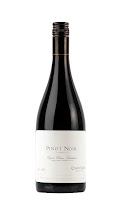I was talking with a friend today, and he had received his club shipment from Melville Winery Estate. In the shipment were three different bottles of Pinot Noir. Each was made with a different clone. You don't know how tempted I was to name this weeks' blog "Clone Wars", but my better sense helped me to hold back.
So what is a clone, and why should it make any difference in the wine you drink?
First, the definition of a "clone" is (Hartman, et. al., 1990 from Ed Hellman, Texas A&M): a genetically uniform group of individuals derived originally from a single individual by asexual propagation (cuttings, grafting, etc). What that means in layman terms is that a new plant is created in the exact image (biologically identical) of another superior grape vine, without the use of a seed. The clone is created from clippings (bud or shoot) from the "mother vine". In this way, the grape grower can populate his/her vineyard with those grapevines that produce the best grapes. The superior grapevine will demonstrate attributes and characteristics that the winemaker finds desirable. However, most vineyards will have a mix of different clones, so that the livelihood of the vineyard is not dependent on a single clone. Also the winemaker may blend the different clones to create a more complex quality wine.
Some of the characteristics that make clones distinct include berry and cluster size, yield, fruit color, phenolics, flavor and aroma, time of budbreak and amount of time to ripen, vine and canopy vigor, cold/heat hardiness, and disease resistance. Obviously, all of these are critical to grape quality, and the eventual wine produced.
When we hear about clones, it is usually in reference to Pinot Noir, but any grape variety can be cloned. It just happens that Pinot Noir is an old variety, and is very susceptible to mutation. Some of Pinot Noirs' "relatives": Pinot Blanc, Pinot Gris, Pinot Meunier. Each differs from the parent grape. If we just look at Pinot Noir, the French have identified over 1000 different clones of Pinot Noir.
 |
| Photo care of Langetwin Winery |
California is a perfect example of how clonal selection affects the wine produced. The early history of Pinot Noir in California was the story of smuggled "suitcase" clippings from Burgundy. For example, cuttings taken from Romanée-Conti (considered the world’s most distinguished Pinot Noir vineyard) were planted, and some had outstanding results, while others didn't do so well. After 1987, Dijon clones began to arrive. All of these clones were identified by a French scientist named Raymond Bernard. He identified individual vines that had different characteristics, propagated them, then assigned numbers to each. Now, clonal selections are registered by the University of California Davis (UCD) and certified by ENTAV (Etablissment National Technique pour l’Amélioration de la Viticulture) in southern France. These registered cloned vines are then named or numbered and propagated on site and cuttings made available to nurseries. There are only four nurseries in North America authorized to propagate and sell ENTAV clones.
So the next time you try Pinot Noir, Chardonnay, or Sangiovese (the grape varieties you'll most likely encounter clones), keep track of which clones are present. Each will have different expressions of the grape variety. Knowing what you like, may help influence your tasting decisions in the future. Form your own opinions and experiment. Just remember that the clone alone, will not affect the final wine....vineyard site, growing practices, and cellar processes will affect the final product.




















